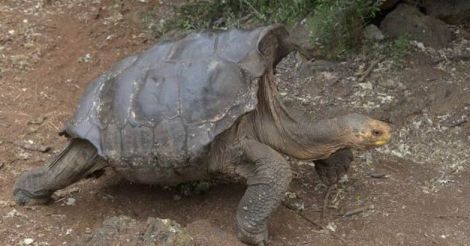He is more than 100 years old. But Diego, the tortoise, has done something no living thing has ever done before!
The Galapagos giant tortoise, has fathered an estimated 800 offspring. He almost single-handedly rebuilding the species' population on their native island, Espanola, the southern-most of the Galapagos Islands (with the help of his mates, of course!)
Around 50 years ago there were only two males and 12 females Galapagos giant tortoises were s alive on Espanola Island. Scientists found he was the father of nearly 40 percent of the offspring released into the wild on Espanola Island.
"He's a very sexually active male reproducer. He's contributed enormously to repopulating the island," Washington Tapia, a tortoise preservation specialist at Galapagos National Park, said.
This species of tortoise is found in the wild only on Espanola Island.
Diego lives at a tortoise breeding center on Santa Cruz Island, one of the largest in the Galapagos.
He is the dominant male of the three assigned to repopulate Espanola. He shares his enclosure with six females, his partners in the task of saving their species.
Diego weighs about 80 kilograms, is nearly 90 centimeters long and 1.5 meters tall, if he stretches his legs and neck.
Diego was found at the San Diego Zoo — hence his name — after Chelonoidis hoodensis was identified as a species and an international campaign was launched to find more of the rare tortoises.
"We don't know exactly how or when he arrived in the United States. He must have been taken from Espanola sometime between 1900 and 1959 by a scientific expedition," Tapia said.
After being located at the zoo in California, Diego was brought back to the Galapagos in 1976 and put in the captive breeding program.
'It's a population that is in pretty good shape'
Little did scientists realize just how effective he was, until six years ago.
In all, around 2,000 tortoises have been released on the small island. Thanks to the program, the species is no longer facing extinction.
"I wouldn't say [the species] is in perfect health, because historical records show there probably used to be more than 5,000 tortoises on the island. But it's a population that's in pretty good shape — and growing, which is the most important," Tapia said.
Of the 15 species of giant tortoise known to have originated in the Galapagos, three have gone extinct — victims of 18th-century pirates who plundered the islands' fragile ecosystem.
Diego's species has also been introduced on the island of Santa Fe, where a genetically similar one, disappeared more than 150 years ago.
Hopes for another threatened species, Chelonoidis abingdoni, faded when its last known survivor died in 2012 at more than 100 years old.
Known as Lonesome George, he had refused for years to breed in captivity.
(With agency inputs)
























